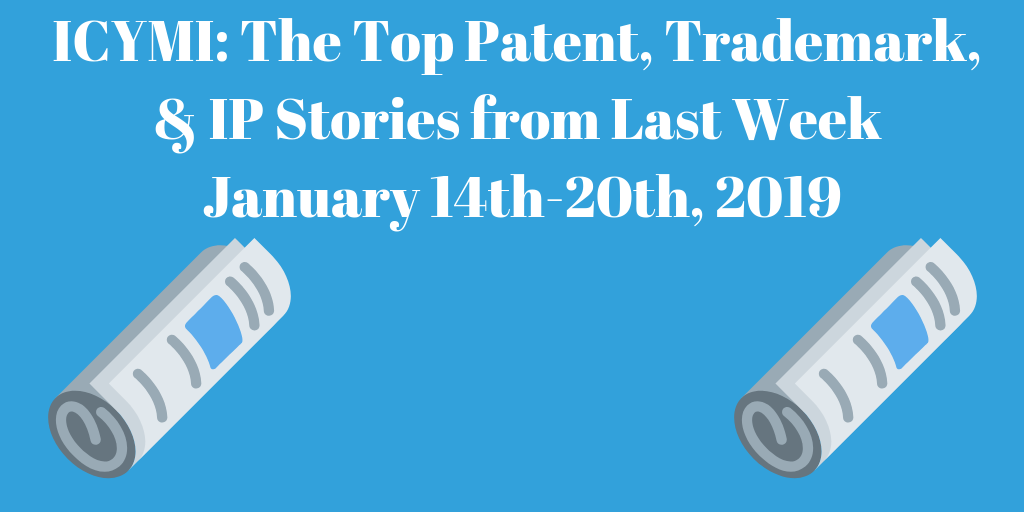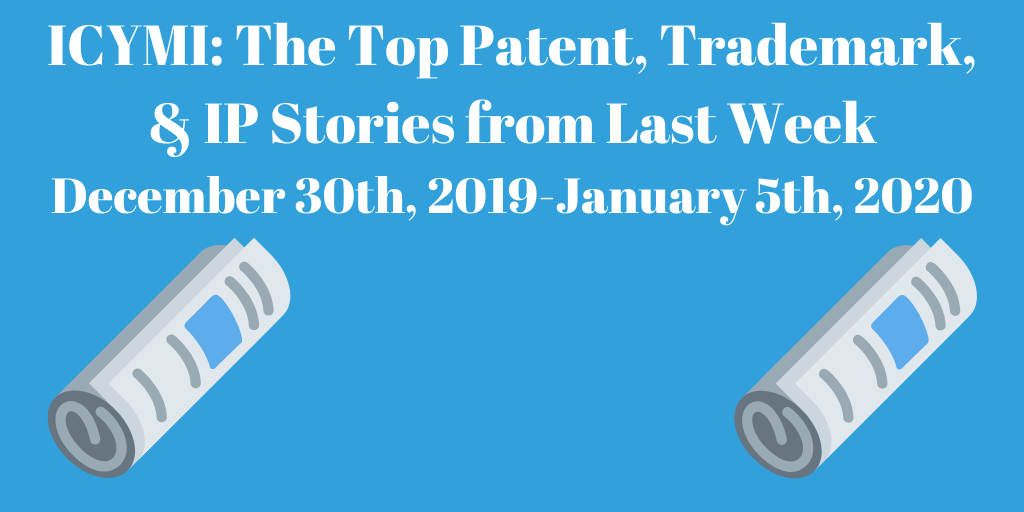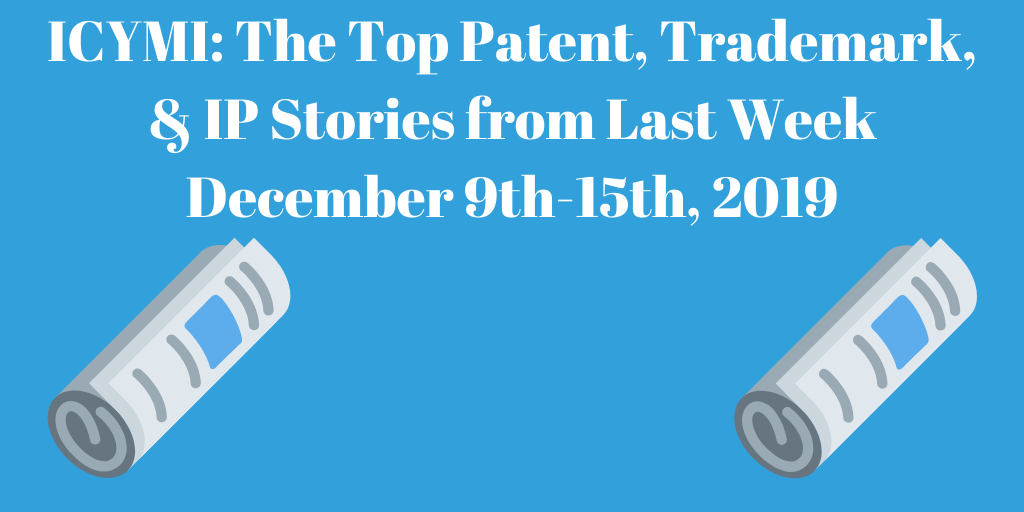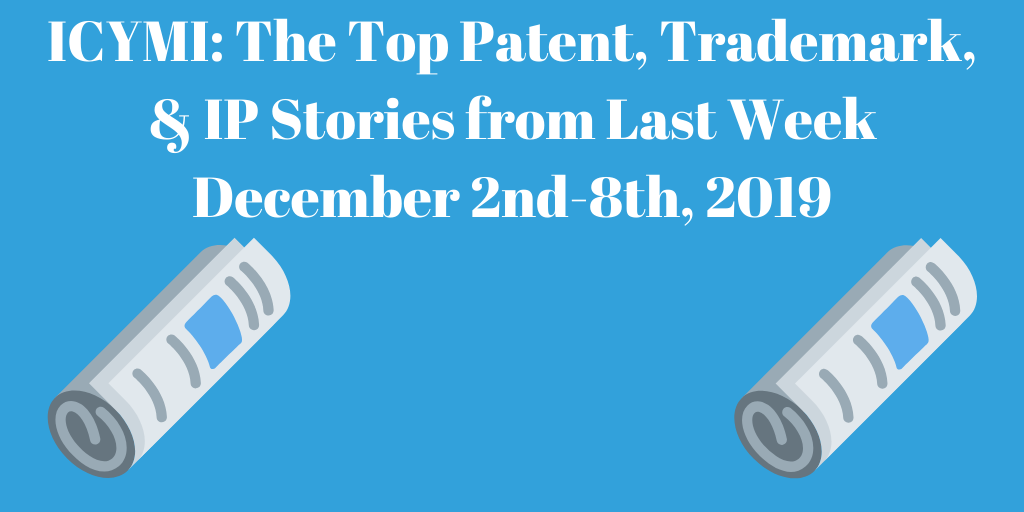Top Patent, Trademark, and IP Stories from Last Week (1/14-1/20/19)
ICYMI: The Top Patent, Trademark, and IP Stories from Last Week (January 14th-20th, 2019)
Every week, we will be highlighting the top patent, copyright, trademark, intellectual property, etc. stories of the previous week in our “In Case You Missed It” segment. The list itself is in no particular order and includes a wide range of stories from the patent world that are informative, noteworthy, or just plain bizarre. The stories included encompass everything from Supreme Court cases to insights into emerging industries. Please feel free to comment your thoughts on the stories or share an important one we missed!
1.) “An Irish Burger Chain Claims a Trademark Win Over McDonald’s”
In an unprecedented ruling across the pond last week, the European Union Intellectual Property Office revoked McDonald’s trademark rights for the “Big Mac” in their European Union restaurants. The ruling comes after a David vs. Goliath battle with Irish fast food chain, Supermac’s, whose trademark application was originally opposed by McDonald’s in 2014.
In that dispute, McDonald’s claimed Supermac’s name and their “Mighty Mac” burger infringed on the “Big Mac” trademark. The Intellectual Property Office had originally ruled in McDonald’s favor, pointing out the similarity between “Big Mac” and “Supermac’s” would “result in a likelihood of confusion.”
However, Supermac’s lawyers later argued McDonald’s had in fact failed to properly register their trademark for the Big Mac. Ultimately the EUIPO agreed, finding McDonald’s application insufficient in showing the Big Mac was “put to genuine use in the union for the goods or services for which it is registered.”
“The basis of their registration was that it would create some confusion with customers as to which restaurant they were in- even though we have a totally different logo, totally different decor, totally different food offering,” Pat McDonagh, founder of Supermac’s, responded after the ruling. McDonald’s plans to appeal the decision. To read more about this story, click here (via The New York Times, January 16th, 2019)
2.) “This Computer Program Makes Pharma Patents Airtight”
The pharmaceutical industry is an absolute behemoth. In 2016 alone, North American pharmaceutical companies raked in more than $446 billion in revenue combined. Given the amount of money put into the research and development of drugs, essential drug pathways and compounds are heavily protected trade secrets. The ability to protect against potential patent theft loopholes is a crucial focus for any pharmaceutical company’s legal team.
Researchers in Poland and South Korea have recently developed software that will aid in helping drug companies identify potential loopholes competitors could exploit. The software retroactively identifies synthetic strategies and pathways that may bypass patented aspects of the drug. It has helped reveal unorthodox, though chemically plausible, substitutes for key synthetic compounds and pathways.
The software has even surprised senior author Bartosz Grzybowski who said “it turns out that the loopholes are there, and we can find new retrosynthetic pathways that circumvent the patents entirely.”
When the simulations come upon bonds and compounds deemed “untouchable” the algorithms simply proposed legally acceptable alternatives. The ease with which the program was allowed to find novel loopholes will surely lead to new approaches to patenting chemical processes and compounds. To read more about this story, click here (via ScienceDaily, January 17th, 2019)
3.) “The U.S. Case Against Huawei Is Getting Real”
Federal authorities have opened an investigation into possible trade secret theft by Huawei Technologies Co. and, by extension, the Chinese government. Huawei is China’s largest phone producer and the national equivalent to Apple in America.
The company has had numerous civil suits levied against them in the United States including a 2017 ruling where a jury found Huawei guilty of stealing T-Mobile robotic technology. The investigation highlights three major complaints the U.S. has against Huawei and China including “breaching sanctions against Iran,” “aiding and abetting espionage,” and “stealing technology.”
The investigation will be an important step in trade talks as the U.S. deals with continual Chinese intellectual property theft. To read more about this story, click here (via Bloomberg, January 16th, 2019)
4.) “Patent Office May Be Unable to Outlast Shutdown Past February”
With the longest government shutdown in U.S. history still underway, the USPTO has indicated the office “remains open for business as normal.” That said, the agency may still be forced to furlough the majority of its 13,000 workers as continues to exhaust the remainder of its reserve funds going into February. The agency expects to run out of funds early to mid-February.
To keep the lights on, the USPTO has been using fees from patent and trademark registration applications collected prior to the start of the shutdown on December 22nd. Fees collected during the shutdown are not able to be used for maintaining operations.
“Should the USPTO exhaust these funds before a partial government shutdown comes to an end, the agency would have to shut down at that time, although a small staff would continue to work to receive new applications and any other examination, post-examination, post-issuance, and PTAB or TTAB filings; receive payments related to such filings; and maintain IT infrastructure, among other functions,” the USPTO said in a statement on their website.
The effects of a USPTO shutdown would be catastrophic for an agency already dealing with backlog overflow and over a half-a-million unexamined patent applications which would inevitably hit small-time inventors the hardest. Such a crisis would also have a domino effect on industry by delaying licensing disputes and infringement lawsuits.
The agency had $135 million in funding for trademark reserves and $312 million for patent operating reserves as of September 30th, well below the $714 million the agency would need for three month operating expenses. To read more about this story, click here (via Bloomberg BNA, January 16th, 2019)
5.) “Google Shows Its Bleak Vision of Search Under New EU Copyright Laws”
The European Union’s proposed “Copyright Directive” is drawing a lot of criticism from European internet users and big time internet companies alike. Article 11 of the proposal, the so-called “link tax,” gives content creators the right to ask for compensation when their content is shared on online platforms. Furthermore, Article 13 indicates the online platforms themselves are liable for infringing content uploaded to their sites.
To no surprise, one of the proposal’s biggest critics is Google who has a lot at stake with the new proposals. For example, they would have to remove thumbnails and preview snippets from search results.
To illustrate the impact of such a law for users, Google has released what this new internet landscape would look like (seen below).

This comes after Richard Gingras, vice president of news at Google, put out a statement in December where he indicated the proposal would have “unintended consequences for smaller news publishers, limit innovation in journalism and reduce choice for European consumers.” Gingras went on to say how having to “strike deals” with content creators would inevitably lead to fewer choices and a less democratic internet.
Although this may not affect American internet users directly, the proposal is an important event in how politicians around the world deal with complicated internet law. To read more about this story, click here (via Engadget, January 16th, 2019).




